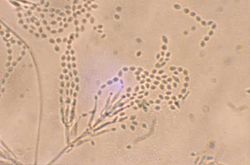热门问题
时间线
聊天
视角
淡紫擬青黴菌
来自维基百科,自由的百科全书
Remove ads
淡紫擬青黴菌(學名:Purpureocillium lilacinum)又稱淡紫紫孢菌[3],是線蟲草科紫孢霉屬的一種真菌[4],已自土壤、沈積物、污泥、昆蟲與線蟲樣本中採得。在線蟲卵中也發現了這種菌,偶爾也會在根結線蟲和胞囊線蟲的雌性體內發現。此外,它也經常出現在許多作物的根際中。在攝氏8-38度的溫度下皆可生長,其中以26-30度較佳,且對pH值與生長基質的耐受範圍也相當廣[5][6]。本種因可感染線蟲而被用於對抗線蟲蟲害的生物防治劑。
Remove ads
分類
淡紫擬青黴菌於1910年由美國真菌學家查爾斯·索姆發表描述,當時被歸入青黴屬中,學名為Penicillium lilacinum[7]。1974年Robert A. Samson將其改歸入擬青黴屬(Paecilomyces)[5]。2000年代的研究發現擬青黴屬非單系群[8][9],後有學者發表新屬紫孢霉屬(Purpureocillium)並將本種分入其中,屬名意指「紫色的孢子」,得名自該屬真菌紫色的分生孢子[10],本種的分生孢子呈橢圓形至梭形,由菌絲末端的特化結構瓶梗產生,分散排列成鏈狀結構,表面光滑至稍微粗糙,尚未觀察到厚垣孢子;菌絲為透明,寬2.5-4微米[5]。
致病
淡紫擬青黴菌在少數情況下可感染人類致病[11][12],大多數患者為免疫缺乏者或體內留置醫療器具(如人工晶狀體)者[13][14],有研究顯示本種可能為感染免疫缺乏與免疫正常者的新興病原[15][16]。
生物防治劑

植物寄生線蟲對多種作物造成重大經濟損失。化學防治是植物寄生線蟲管理中廣泛使用的方法。然而,由於環境危害、成本高、在許多發展中國家供應有限或重複使用後藥效降低,化學殺線蟲劑目前正在重新評估。
1966年即有研究發現淡紫擬青黴菌可感染線蟲的卵[17],其菌絲在線蟲卵的表面上生長後可形成附着器(菌絲尖端的膨大特化結構),進而穿透卵殼、殺死線蟲、並產生更多的分生孢子以繼續感染周圍的卵。目前淡紫擬青黴菌已自多種線蟲與多個地區的土壤樣本中被發現[18][19]。本種可用於生物防治以對抗線蟲的蟲害,祕魯已有數個野外試驗成功使用本種抑制線蟲蟲害[20],當地的品系進而被送至世界各地不同氣候、作物的環境下進行測試[21],各品系感染線蟲的毒力不同,有時,在體外或溫室試驗中看起來很有希望的品系卻無法在田間提供控制。[22]。
人們已經研究了淡紫擬青黴菌(P. lilacinum)產生的多種酶。其中一種具有抗北方根結線蟲(Meloidogyne hapla)卵生物活性的鹼性絲氨酸蛋白酶已被鑑定[23]。一種淡紫擬青黴菌菌株已被證明能夠產生蛋白酶和幾丁質酶,這些酶可以削弱線蟲卵殼,使狹窄的感染栓能夠穿過。[24]
參考文獻
Wikiwand - on
Seamless Wikipedia browsing. On steroids.
Remove ads

